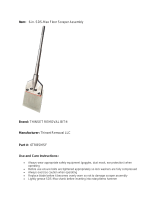
Introduction
The following information is intended as an overview of the tile installation process. It is not meant as a step-
by-step instruction manual, but rather as a way to familiarize yourself with the basic process. Carefully follow
all instructions provided by the manufacturers of your setting materials to ensure success.
Tools
Have the right tools and installation products before you
begin your tile installation. Some of the supplies you may
need are a wet saw, tile nippers, safety glasses, trowels,
sponges, grout, tile spacers, thinset, gloves, a grout oat,
and a few buckets.
Surface Preparation
Your installation surface or suboor (if using oor-rated
tile) must be sound, at, solid, and clean of all debris.
Layout/Dry Laying
Plan your layout by measuring carefully to minimize cuts,
and dry lay your tiles for t. Ensure that all of your tiles
are marked as the same dye lot number. Additionally, it is
benecial to mix tiles from different cases to prevent any
obvious shade variations.
Cutting Tile
If you need to cut the tile, use tile nippers, a tile cutter,
or a diamond-tipped wet saw to cut it to a desired size.
Follow safety precautions and wear protective glasses.
Thinset and Mastic
Be sure to select the correct type of adhesive suitable
for your installation. This can vary by tile material and
installation location. There are a variety of adhesives
available, such as mastic, thinset, polymer-modied
thinset and epoxy. Follow the instructions provided by the
manufacturer of your chosen adhesive.
Laying the Tiles
Apply the thinset with an appropriately-sized notched
trowel, then lay and press the tiles in place, using a
rubber mallet if needed. Use spacers to create uniform
grout lines.
Grout Selection
Sanded or non-sanded grout should be used,
depending on the product you are installing. Floor tiles
must be grouted. For grout lines of 1/8” and larger,
sanded grout is more suitable. The sand in the grout
mixture decreases the shrinkage as it cures, making it
ideal for wider grout lines. Non-sanded grout is used for
grout lines 1/8” and smaller. It’s also best for mosaics and
decorative tiles with delicate nishes, such as metallic
pieces or high gloss products, as the texture of sanded
grout can scratch them.
Applying Grout
The setting material must be fully dry before attempting
to grout. Consult the instructions for your setting
material to nd the recommended drying time. Apply
grout in small sections using a rubber oat. Pull the grout
across the surface, pushing it fully into the grout lines and
keeping excess from building up on the tile surface. Keep
the grout level, without any pits or low spots.
Grout Cleanup
With a dry, lint-free cloth, remove excess grout from the
surface of the tile. Lightly dampen a sponge with warm
water and continue to clean grout off of the tile. Once
it appears to be clean, wipe it down again with a fresh,
lightly damp sponge to remove any grout lm. After about
15 minutes, buff the tile with a soft cloth. Finished grout
should be smooth, uniform in color, and have no visible
holes, pits, or uneven height issues.
Mesh Backing
Our mosaic tiles have a mesh backing that ensures
appropriate bonding during installation. For
optimal performance, avoid exposing the mesh to
excessive moisture before installation, which could
result in the tiles falling off the mesh backing. For
this reason, it may be benecial to remove the tiles
from the mesh and cut them individually with tile
cutters or nippers rather than with a wet saw.
Stainless Steel and Aluminum Mosaics
You can prevent scratches on these surfaces by
using a clean sponge, keeping the protective
cover on and applying non-sanded grout during
installation. If necessary, cut this tile from the
rear with a diamond-tipped wet saw to prevent
uneven edges. Cut edges can then be treated
and smoothed with ne sandpaper or a metal
le.
Grout color is a matter of personal taste. Please note that
grout colors have a drastic impact on the look of your
installation. We have a blog post about the color choice
process at this web address:
https://merolatile.wordpress.com/2014/03/14/all-
about-grout/.
Special Notes for Mosaic Tiles
Tile Installation Guide
Improving Homes. Improving Lives.






